Wildfire Risk Assessment in Ambato, Ecuador: Drought Impacts, Fuel Dynamics, and Wildland–Urban Interface Vulnerability
Abstract
1. Introduction
2. Materials and Methods
2.1. Study Area
2.2. Data Sources
2.3. Spatial and Climatic Data Processing
2.4. Predictive Modeling and Risk Analysis with Machine Learning
2.5. Validation and Analysis
3. Results
3.1. Identification of High-Risk Areas
3.2. Climatic Factors
3.3. Human Factors
3.4. Socio-Economic Vulnerabilities and Fire Risk
3.5. Data Correlation Analysis
3.6. Model Predictions
3.6.1. Multinomial Logistic Regression (MLR)
3.6.2. Random Forest
3.6.3. XGBoost
4. Discussion
4.1. Mitigation Strategies and Policy Recommendations
4.2. Study Limitations and Future Directions
5. Conclusions
Author Contributions
Funding
Institutional Review Board Statement
Informed Consent Statement
Data Availability Statement
Acknowledgments
Conflicts of Interest
References
- Kirschner, J.A.; Clark, J.; Boustras, G. Governing Wildfires: Toward a Systematic Analytical Framework. Ecol. Soc. 2023, 28, 6. [Google Scholar] [CrossRef]
- Kim, K.; Park, J.; Eem, S.; Kwag, S. Methodology for Generating Wildfire Hazard Map for Safety Assessment of Off-Site Power Systems against Wildfires. Nucl. Eng. Technol. 2024, 57, 103327. [Google Scholar] [CrossRef]
- Villaverde Canosa, I.; Ford, J.; Paavola, J.; Burnasheva, D. Community Risk and Resilience to Wildfires: Rethinking the Complex Human–Climate–Fire Relationship in High-Latitude Regions. Sustainability 2024, 16, 957. [Google Scholar] [CrossRef]
- Vaiciulyte, S.; Rivero-Villar, A.; Guibrunet, L. Emerging Risks of Wildfires at the Wildland-Urban Interface in Mexico. Fire Technol. 2023, 59, 983–1006. [Google Scholar] [CrossRef]
- Xu, Y.; Guo, H.; Liu, J.; Sun, R.; Li, X. Wildfire Risks under a Changing Climate: Synthesized Assessments of Wildfire Risks over Southwestern China. Front. Environ. Sci. 2023, 11, 1137372. [Google Scholar] [CrossRef]
- Almeida, P.; Menezes, I.C.; Miranda, A.I. A Human Behavior Wildfire Ignition Probability Index for Application to Mainland Portugal. Fire 2024, 7, 447. [Google Scholar] [CrossRef]
- Dorph, A.; Marshall, E.; Parkins, K.A.; Penman, T.D. Modelling Ignition Probability for Human- and Lightning-Caused Wildfires in Victoria, Australia. Nat. Hazards Earth Syst. Sci. 2022, 22, 3487–3499. [Google Scholar] [CrossRef]
- Lindberg, H.; Aakala, T.; Vanha-Majamaa, I. Ignition Probability and Fuel Consumption of Boreal Ground Vegetation Fuels—An Experimental Study in Finland. Silva Fenn. 2024, 58, 23064. [Google Scholar] [CrossRef]
- Mozumder, P.; Helton, R.; Berrens, R.P. Provision of a Wildfire Risk Map: Informing Residents in the Wildland Urban Interface. Risk Anal. 2009, 29, 1588–1600. [Google Scholar] [CrossRef]
- D’Este, M.; Giannico, V.; Lafortezza, R.; Sanesi, G.; Elia, M. The Wildland-Urban Interface Map of Italy: A Nationwide Dataset for Wildfire Risk Management. Data Brief 2021, 38, 107427. [Google Scholar] [CrossRef]
- Gonzalez, S.; Ghermandi, L. How to Define the Wildland-Urban Interface? Methods and Limitations: Towards a Unified Protocol. Front. Environ. Sci. 2023, 11, 1284631. [Google Scholar] [CrossRef]
- Mahamed, M.; Wittenberg, L.; Kutiel, H.; Brook, A. Fire Risk Assessment on Wildland–Urban Interface and Adjoined Urban Areas: Estimation Vegetation Ignitability by Artificial Neural Network. Fire 2022, 5, 184. [Google Scholar] [CrossRef]
- Mitsopoulos, I.; Mallinis, G.; Arianoutsou, M. Wildfire Risk Assessment in a Typical Mediterranean Wildland–Urban Interface of Greece. Environ. Manag. 2014, 55, 900–915. [Google Scholar] [CrossRef]
- Murray, A.T.; Baik, J.; Echeverri Figueroa, V.; Rini, D.; Moritz, M.A.; Roberts, D.A.; Sweeney, S.H.; Carvalho, L.M.V.; Jones, C. Developing Effective Wildfire Risk Mitigation Plans for the Wildland Urban Interface. Int. J. Appl. Earth Obs. Geoinf. 2023, 124, 103531. [Google Scholar]
- Tampekis, S.; Sakellariou, S.; Palaiologou, P.; Arabatzis, G.; Kantartzis, A.; Malesios, C.; Stergiadou, A.; Fafalis, D.; Tsiaras, E. Building Wildland–Urban Interface Zone Resilience through Performance-Based Wildfire Engineering. A Holistic Theoretical Framework. Euro-Mediterr. J. Environ. Integr. 2023, 8, 675–689. [Google Scholar] [CrossRef]
- Herrmann, P. Management Conflicts in the Ambato River Watershed, Tungurahua Province, Ecuador. Mt. Res. Dev. 2002, 22, 338–340. [Google Scholar] [CrossRef]
- González, F.; Morante-Carballo, F.; González, A.; Bravo-Montero, L.; Benavidez-Silva, C.; Tedim, F. Assessment of Forest Fire Severity for a Management Conceptual Model: Case Study in Vilcabamba, Ecuador. Forests 2024, 15, 2210. [Google Scholar] [CrossRef]
- Arias-Muñoz, P.; Cabrera-García, S.; Jácome-Aguirre, G. A Multicriteria Geographic Information System Analysis of Wildfire Susceptibility in the Andean Region: A Case Study in Ibarra, Ecuador. Fire 2024, 7, 81. [Google Scholar] [CrossRef]
- Ambato Fire Department Database of Fires in Ambato. 2024. Available online: https://www.datosabiertos.gob.ec/dataset/superficie-afectada-por-incendios-forestales-en-el-marco-de-mecanismos-de-conservacion/resource/ec87ad4e-9ce2-449e-9378-bbfdc8c4089a (accessed on 18 December 2024).
- Honorable Gobierno Provincial de Tungurahua Red Hidrometeorológica de Tungurahua, Geoportal. Available online: https://rrnn.tungurahua.gob.ec/ (accessed on 15 December 2024).
- Gobierno Autónomo Descentralizado de Ambato Geoportal Servicios Virtuales. Available online: https://geoambato-gadma.opendata.arcgis.com/ (accessed on 26 December 2024).
- Roman, M.; Zubieta, R.; Ccanchi, Y.; Martínez, A.; Paucar, Y.; Alvarez, S.; Loayza, J.; Ayala, F. Seasonal Effects of Wildfires on the Physical and Chemical Properties of Soil in Andean Grassland Ecosystems in Cusco, Peru: Pending Challenges. Fire 2024, 7, 259. [Google Scholar] [CrossRef]
- Liu, Y.; Qian, Y.; Rasch, P.J.; Zhang, K.; Leung, L.Y.R.; Wang, Y.; Wang, M.; Wang, H.; Huang, X.; Yang, X.Q. Fire-Precipitation Interactions Amplify the Quasi-Biennial Variability in Fires over Southern Mexico and Central America. Atmos. Chem. Phys. 2024, 24, 3115–3128. [Google Scholar] [CrossRef]
- Moratalla, A.Z.; Baeriswyl, S. Metodología Para El Desarrollo Del Mapa Vulnerabilidad Urbana Frente a Incendios Forestales En La Región Del Biobío y Ñuble. Available online: https://www.researchgate.net/profile/Sergio-Baeriswyl-2/publication/378339324_Metodologia_para_el_desarrollo_del_mapa_vulnerabilidad_urbana_frente_a_incendios_forestales_en_la_region_del_Biobio_y_Nuble/links/65d572a7e7670d36abc5e858/Metodologia-para-el-desarrollo-del-mapa-vulnerabilidad-urbana-frente-a-incendios-forestales-en-la-region-del-Biobio-y-Nuble.pdf (accessed on 26 December 2024).
- Aksoy, E.; Kocer, A.; Yilmaz, İ.; Akçal, A.N.; Akpinar, K. Assessing Fire Risk in Wildland–Urban Interface Regions Using a Machine Learning Method and GIS Data: The Example of Istanbul’s European Side. Fire 2023, 6, 408. [Google Scholar] [CrossRef]
- Shao, Y.; Feng, Z.; Sun, L.; Yang, X.; Li, Y.; Xu, B.; Chen, Y. Mapping China’s Forest Fire Risks with Machine Learning. Forests 2022, 13, 856. [Google Scholar] [CrossRef]
- Zhong, W.; Wang, S.; Wu, T.; Gao, X.; Liang, T. Optimized Machine Learning Model for Fire Consequence Prediction. Fire 2024, 7, 114. [Google Scholar] [CrossRef]
- Moghim, S.; Mehrabi, M. Wildfire Assessment Using Machine Learning Algorithms in Different Regions. Fire Ecol. 2024, 20, 104. [Google Scholar] [CrossRef]
- Perello, N.; Meschi, G.; Trucchia, A.; D’Andrea, M.; Baghino, F.; Esposti, S.D.; Fiorucci, P. Machine Learning-Driven Dynamic Maps Supporting Wildfire Risk Management. IFAC-PapersOnLine 2024, 58, 67–72. [Google Scholar] [CrossRef]
- Xu, Y.; Li, D.; Ma, H.; Lin, R.; Zhang, F. Modeling Forest Fire Spread Using Machine Learning-Based Cellular Automata in a GIS Environment. Forests 2022, 13, 1974. [Google Scholar] [CrossRef]
- Wickramasinghe, A.M.K.; Boer, M.M.; Cunningham, C.X.; Nolan, R.H.; Bowman, D.M.J.S.; Williamson, G.J. Modeling the Probability of Dry Lightning-Induced Wildfires in Tasmania: A Machine Learning Approach. Geophys. Res. Lett. 2024, 51, e2024GL110381. [Google Scholar] [CrossRef]
- Khodaee, M.; Easterday, K.; Klausmeyer, K. Integrating Hydrological Parameters in Wildfire Risk Assessment: A Machine Learning Approach for Mapping Wildfire Probability. Environ. Res. Lett. 2024, 19, 114043. [Google Scholar] [CrossRef]
- Wasserman, T.N.; Mueller, S.E. Climate Influences on Future Fire Severity: A Synthesis of Climate-Fire Interactions and Impacts on Fire Regimes, High-Severity Fire, and Forests in the Western United States. Fire Ecol. 2023, 19, 43. [Google Scholar] [CrossRef]
- Synolakis, C.E.; Karagiannis, G.M. Wildfire Risk Management in the Era of Climate Change. Proc. Natl. Acad. Sci. Nexus 2024, 3, pgae151. [Google Scholar] [CrossRef]
- Campbell, T.; Bradshaw, S.D.; Dixon, K.W.; Zylstra, P. Wildfire Risk Management across Diverse Bioregions in a Changing Climate. Geomat. Nat. Hazards Risk 2022, 13, 2405–2424. [Google Scholar] [CrossRef]
- Lambrechts, H.A.; Stoof, C.R.; del Pozo, M.; Ludwig, F.; Paparrizos, S. The Role of Weather and Climate Information Services to Support in Wildfire Management in Northwestern Europe. Clim. Risk Manag. 2024, 46, 100672. [Google Scholar] [CrossRef]
- Cordero, R.R.; Feron, S.; Damiani, A.; Carrasco, J.; Karas, C.; Wang, C.; Kraamwinkel, C.T.; Beaulieu, A. Extreme Fire Weather in Chile Driven by Climate Change and El Niño–Southern Oscillation (ENSO). Sci. Rep. 2024, 14, 1974. [Google Scholar] [CrossRef] [PubMed]
- Villagra, P.E.; Cesca, E.; Alvarez, L.M.; Delgado, S.; Villalba, R. Spatial and Temporal Patterns of Forest Fires in the Central Monte: Relationships with Regional Climate. Ecol. Process 2024, 13, 5. [Google Scholar] [CrossRef]
- Balch, J.K.; Bradley, B.A.; Abatzoglou, J.T.; Chelsea Nagy, R.; Fusco, E.J.; Mahood, A.L. Human-Started Wildfires Expand the Fire Niche across the United States. Proc. Natl. Acad. Sci. USA 2017, 114, 2946–2951. [Google Scholar] [CrossRef]
- Burke, M.; Driscoll, A.; Heft-Neal, S.; Xue, J.; Burney, J.; Wara, M. The Changing Risk and Burden of Wildfire in the United States. Proc. Natl. Acad. Sci. USA 2021, 118, e2011048118. [Google Scholar] [CrossRef]
- Rasilla, D.F.; García-Codron, J.C.; Carracedo, V.; Diego, C. Circulation Patterns, Wildfire Risk and Wildfire Occurrence at Continental Spain. Phys. Chem. Earth 2010, 35, 553–560. [Google Scholar] [CrossRef]
- van der Schriek, T.; Varotsos, K.V.; Karali, A.; Giannakopoulos, C. Wildfire Burnt Area and Associated Greenhouse Gas Emissions under Future Climate Change Scenarios in the Mediterranean: Developing a Robust Estimation Approach. Fire 2024, 7, 324. [Google Scholar] [CrossRef]
- Trucchia, A.; Meschi, G.; Fiorucci, P.; Provenzale, A.; Tonini, M.; Pernice, U. Wildfire Hazard Mapping in the Eastern Mediterranean Landscape. Int. J. Wildland Fire 2023, 32, 417–434. [Google Scholar] [CrossRef]
- Rodrigues, M.; Zúñiga-Antón, M.; Alcasena, F.; Gelabert, P.; Vega-Garcia, C. Integrating Geospatial Wildfire Models to Delineate Landscape Management Zones and Inform Decision-Making in Mediterranean Areas. Saf. Sci. 2022, 147, 105616. [Google Scholar] [CrossRef]
- Hai, T.; Theruvil Sayed, B.; Majdi, A.; Zhou, J.; Sagban, R.; Band, S.S.; Mosavi, A. An Integrated GIS-Based Multivariate Adaptive Regression Splines-Cat Swarm Optimization for Improving the Accuracy of Wildfire Susceptibility Mapping. Geocarto Int. 2023, 38, 2167005. [Google Scholar] [CrossRef]
- Shin, S.S.; Park, S.D.; Kim, G. Applicability Comparison of GIS-Based RUSLE and SEMMA for Risk Assessment of Soil Erosion in Wildfire Watersheds. Remote Sens. 2024, 16, 932. [Google Scholar] [CrossRef]
- Magalhães, M.R.; Cunha, N.S.; Pena, S.B.; Müller, A. FIRELAN—An Ecologically Based Planning Model towards a Fire Resilient and Sustainable Landscape. A Case Study in Center Region of Portugal. Sustainability 2021, 13, 7055. [Google Scholar] [CrossRef]
- Ascoli, D.; Plana, E.; Oggioni, S.D.; Tomao, A.; Colonico, M.; Corona, P.; Giannino, F.; Moreno, M.; Xanthopoulos, G.; Kaoukis, K.; et al. Fire-Smart Solutions for Sustainable Wildfire Risk Prevention: Bottom-up Initiatives Meet Top-down Policies under EU Green Deal. Int. J. Disaster Risk Reduct. 2023, 92, 103715. [Google Scholar] [CrossRef]
- Stasiewicz, A.M.; Paveglio, T.B. Preparing for Wildfire Evacuation and Alternatives: Exploring Influences on Residents’ Intended Evacuation Behaviors and Mitigations. Int. J. Disaster Risk Reduct. 2021, 58, 102177. [Google Scholar] [CrossRef]
- De Freitas, A.; Ferreira, J.; Escada, M.; Reis, J.; Leite, C.; Andrade, D.; Spínola, J.; Soares, M.; Anderson, L. Fire Exposure Index as a Tool for Guiding Prevention and Management. Front. Phys. 2022, 10, 1064162. [Google Scholar] [CrossRef]
- Ferreira Barbosa, M.L.; Haddad, I.; da Silva Nascimento, A.L.; Máximo da Silva, G.; Moura da Veiga, R.; Hoffmann, T.B.; Rosane de Souza, A.; Dalagnol, R.; Susin Streher, A.; Souza Pereira, F.R.; et al. Compound Impact of Land Use and Extreme Climate on the 2020 Fire Record of the Brazilian Pantanal. Glob. Ecol. Biogeogr. 2022, 31, 1960–1975. [Google Scholar] [CrossRef]
- Canadas, M.J.; Leal, M.; Soares, F.; Novais, A.; Ribeiro, P.F.; Schmidt, L.; Delicado, A.; Moreira, F.; Bergonse, R.; Oliveira, S.; et al. Wildfire Mitigation and Adaptation: Two Locally Independent Actions Supported by Different Policy Domains. Land Use Policy 2023, 124, 106444. [Google Scholar] [CrossRef]
- Byerly, H.; Meldrum, J.R.; Brenkert-Smith, H.; Champ, P.; Gomez, J.; Falk, L.; Barth, C. Developing Behavioral and Evidence-Based Programs for Wildfire Risk Mitigation. Fire 2020, 3, 66. [Google Scholar] [CrossRef]
- Chas-Amil, M.L.; Prestemon, J.P.; McClean, C.J.; Touza, J. Human-Ignited Wildfire Patterns and Responses to Policy Shifts. Appl. Geogr. 2015, 56, 164–176. [Google Scholar] [CrossRef]
- de Andrade, A.S.R.; Ramos, R.M.; Sano, E.E.; Libonati, R.; Santos, F.L.M.; Rodrigues, J.A.; Giongo, M.; da Franca, R.R.; Laranja, R.E. de P. Implementation of Fire Policies in Brazil: An Assessment of Fire Dynamics in Brazilian Savanna. Sustainability 2021, 13, 11532. [Google Scholar] [CrossRef]
- Erni, S.; Wang, X.; Swystun, T.; Taylor, S.W.; Parisien, M.A.; Robinne, F.N.; Eddy, B.; Oliver, J.; Armitage, B.; Flannigan, M.D. Mapping Wildfire Hazard, Vulnerability, and Risk to Canadian Communities. Int. J. Disaster Risk Reduct. 2024, 101, 104221. [Google Scholar] [CrossRef]
- Karimi, N.; Mahler, P.; Beverly, J.L. Optimizing Fuel Treatments for Community Wildfire Mitigation Planning. J. Environ. Manag. 2024, 370, 122325. [Google Scholar] [CrossRef] [PubMed]
- Misal, H.; Varela, E.; Voulgarakis, A.; Rovithakis, A.; Grillakis, M.; Kountouris, Y. Assessing Public Preferences for a Wildfire Mitigation Policy in Crete, Greece. For. Policy Econ. 2023, 153, 102976. [Google Scholar] [CrossRef]
- Roengtam, S.; Agustiyara, A. Collaborative Governance for Forest Land Use Policy Implementation and Development. Cogent Soc. Sci. 2022, 8, 2073670. [Google Scholar] [CrossRef]
- Huidobro, G.; Giessen, L.; Burns, S.L. And It Burns, Burns, Burns, the Ring-of-Fire: Reviewing and Harmonizing Terminology on Wildfire Management and Policy. Environ. Sci. Policy 2024, 157, 103776. [Google Scholar]
- Pandey, P.; Huidobro, G.; Lopes, L.F.; Ganteaume, A.; Ascoli, D.; Colaco, C.; Xanthopoulos, G.; Giannaros, T.M.; Gazzard, R.; Boustras, G.; et al. A Global Outlook on Increasing Wildfire Risk: Current Policy Situation and Future Pathways. Trees For. People 2023, 14, 100431. [Google Scholar] [CrossRef]
- Oliveira, S.; Rocha, J.; Sá, A. Wildfire Risk Modeling. Curr. Opin. Environ. Sci. Health 2021, 23, 100274. [Google Scholar]
- Maestas, J.D.; Smith, J.T.; Allred, B.W.; Naugle, D.E.; Jones, M.O.; O’Connor, C.; Boyd, C.S.; Davies, K.W.; Crist, M.R.; Olsen, A.C. Using Dynamic, Fuels-Based Fire Probability Maps to Reduce Large Wildfires in the Great Basin. Rangel. Ecol. Manag. 2023, 89, 33–41. [Google Scholar] [CrossRef]
- Sil, Â.; Azevedo, J.C.; Fernandes, P.M.; Honrado, J.P. Will Fire-Smart Landscape Management Buffer the Effects of Climate and Land-Use Changes on Fire Regimes? Ecol. Process. 2024, 13, 57. [Google Scholar] [CrossRef]

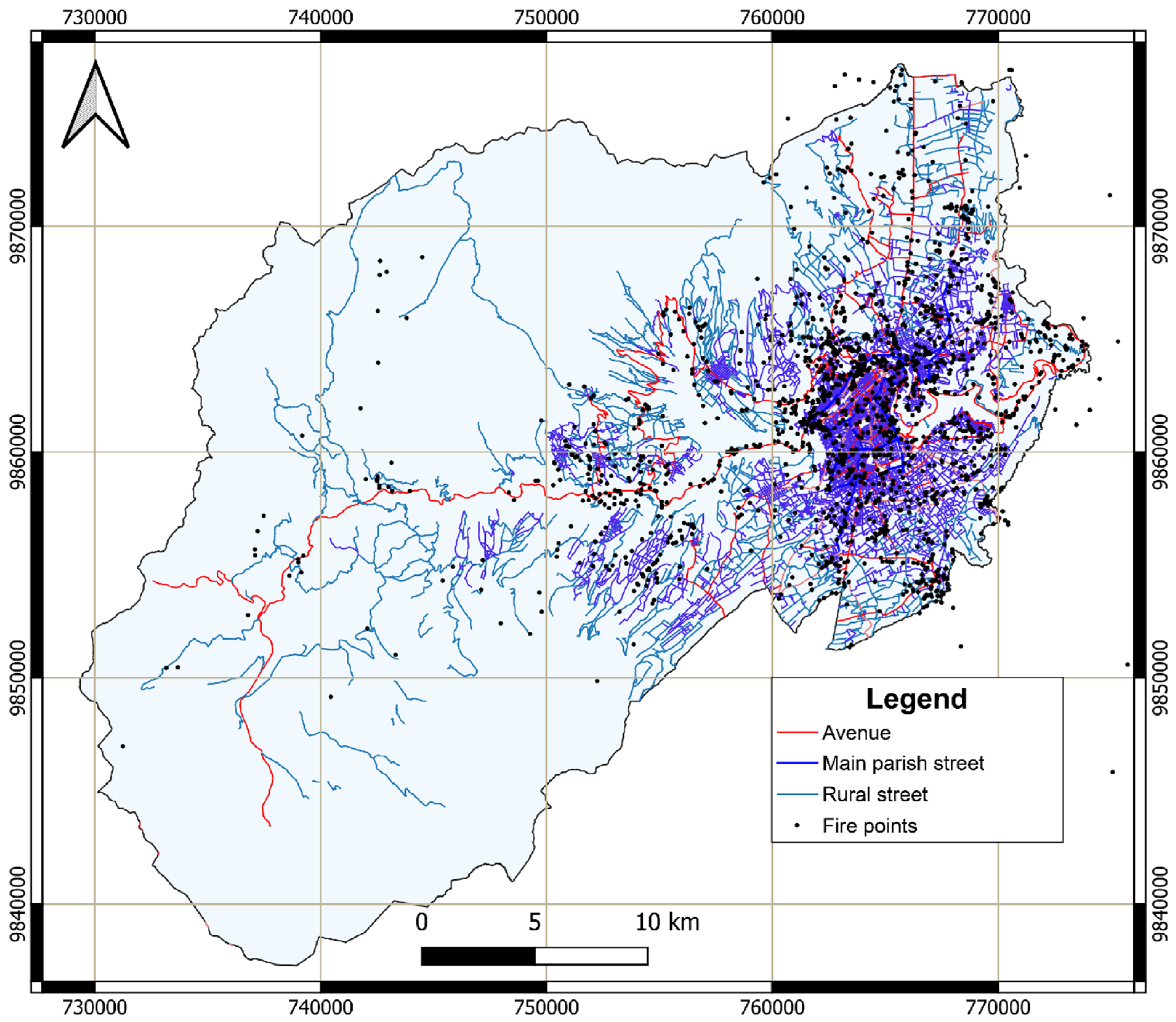
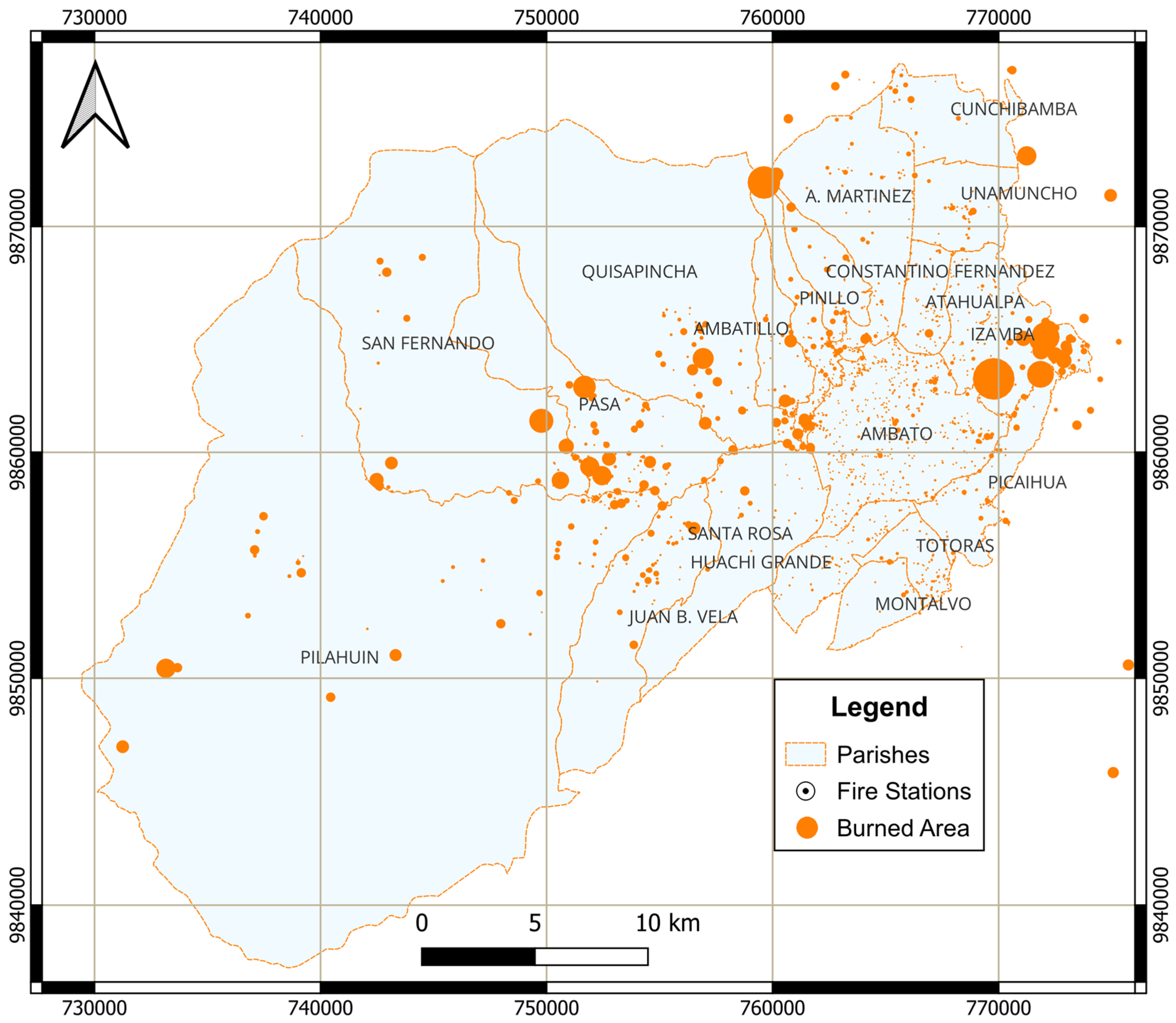

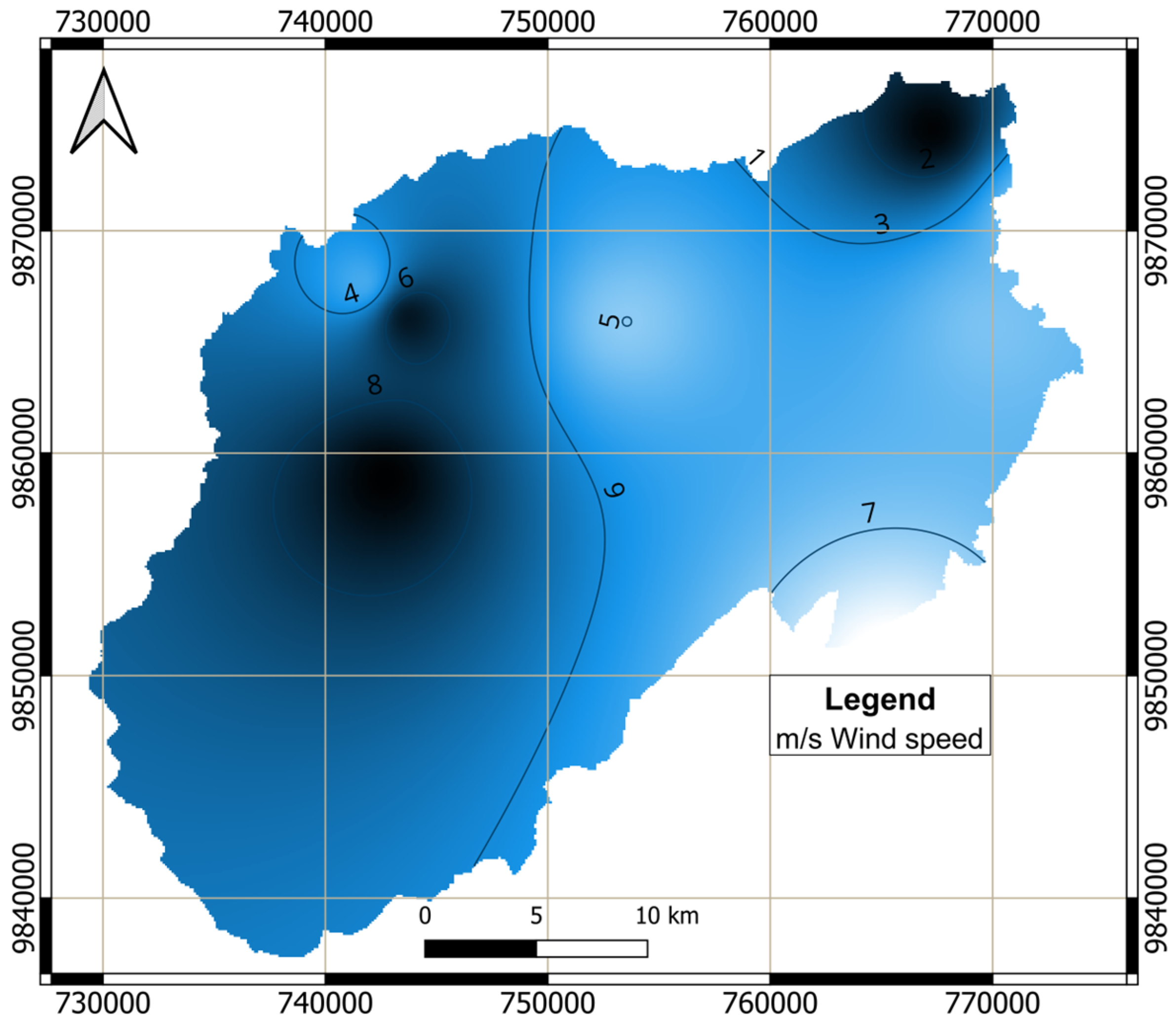
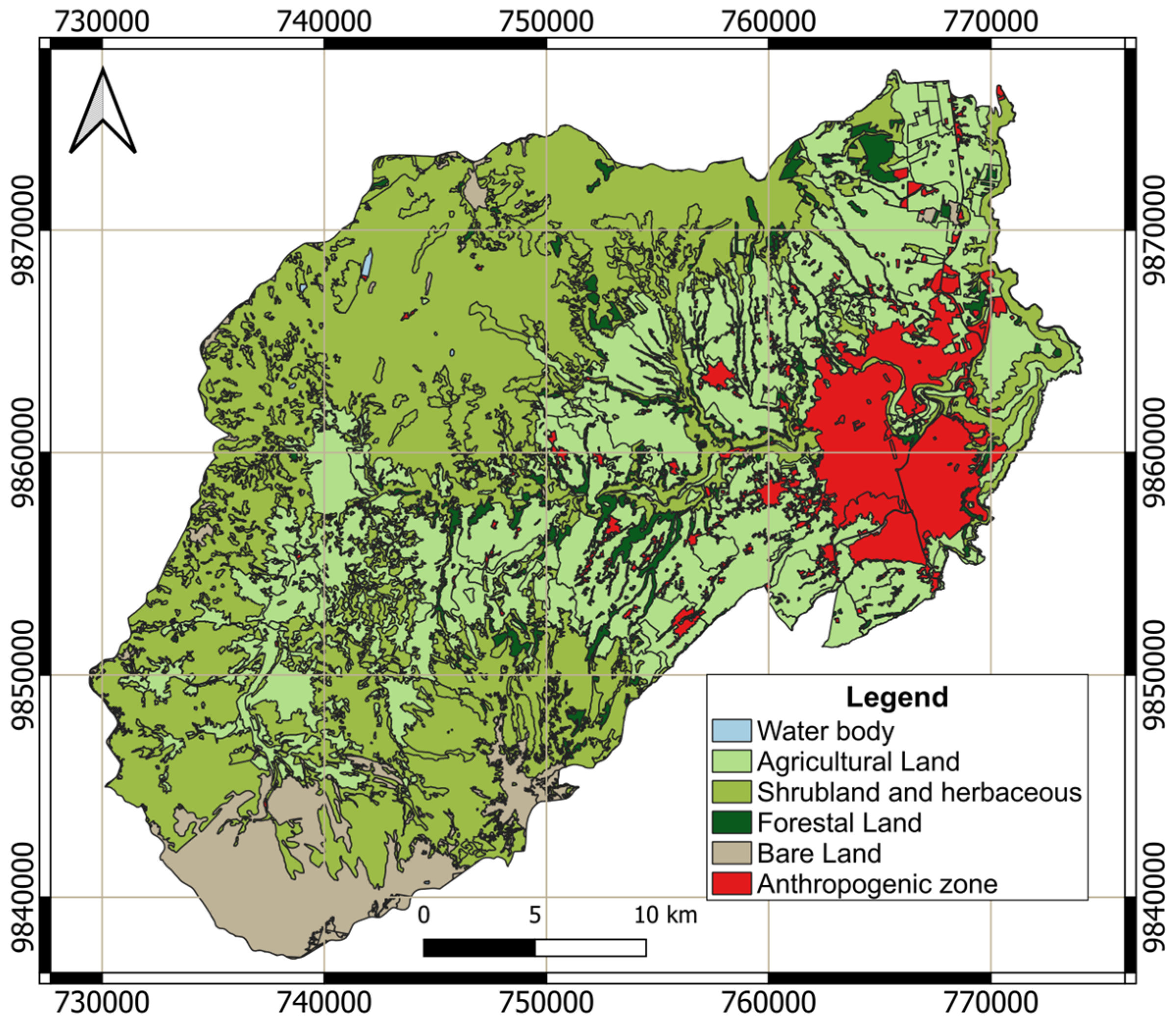
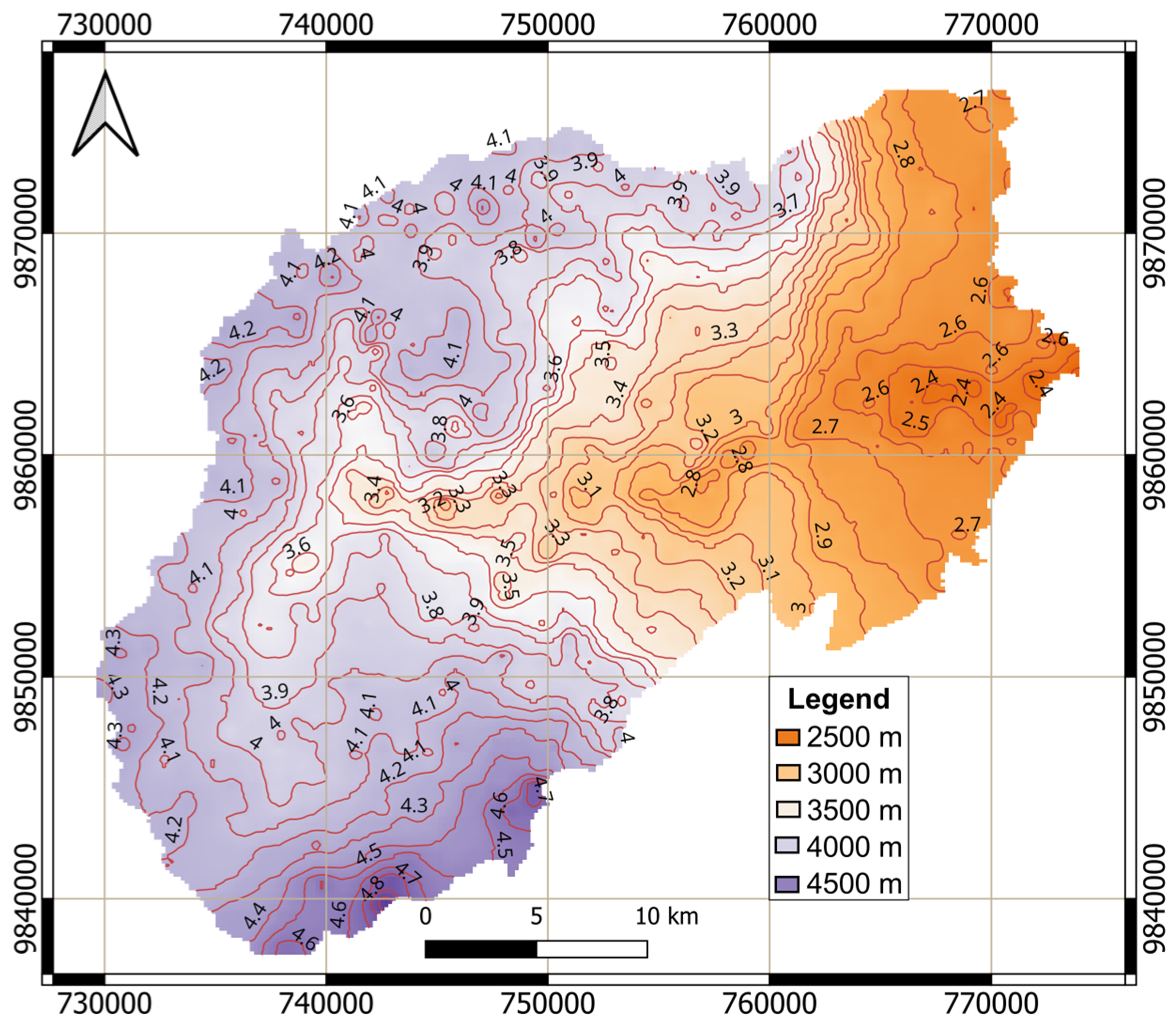
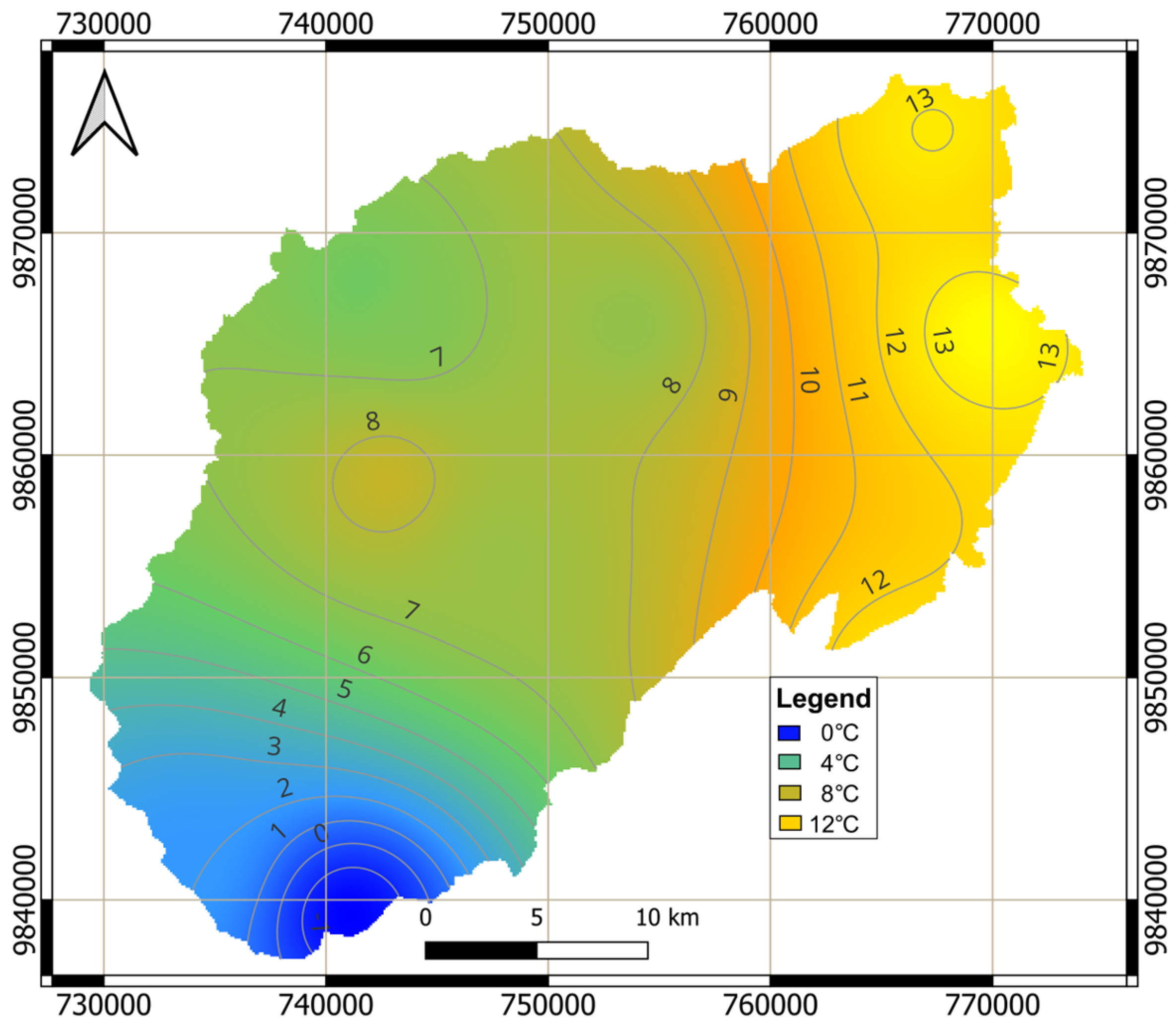
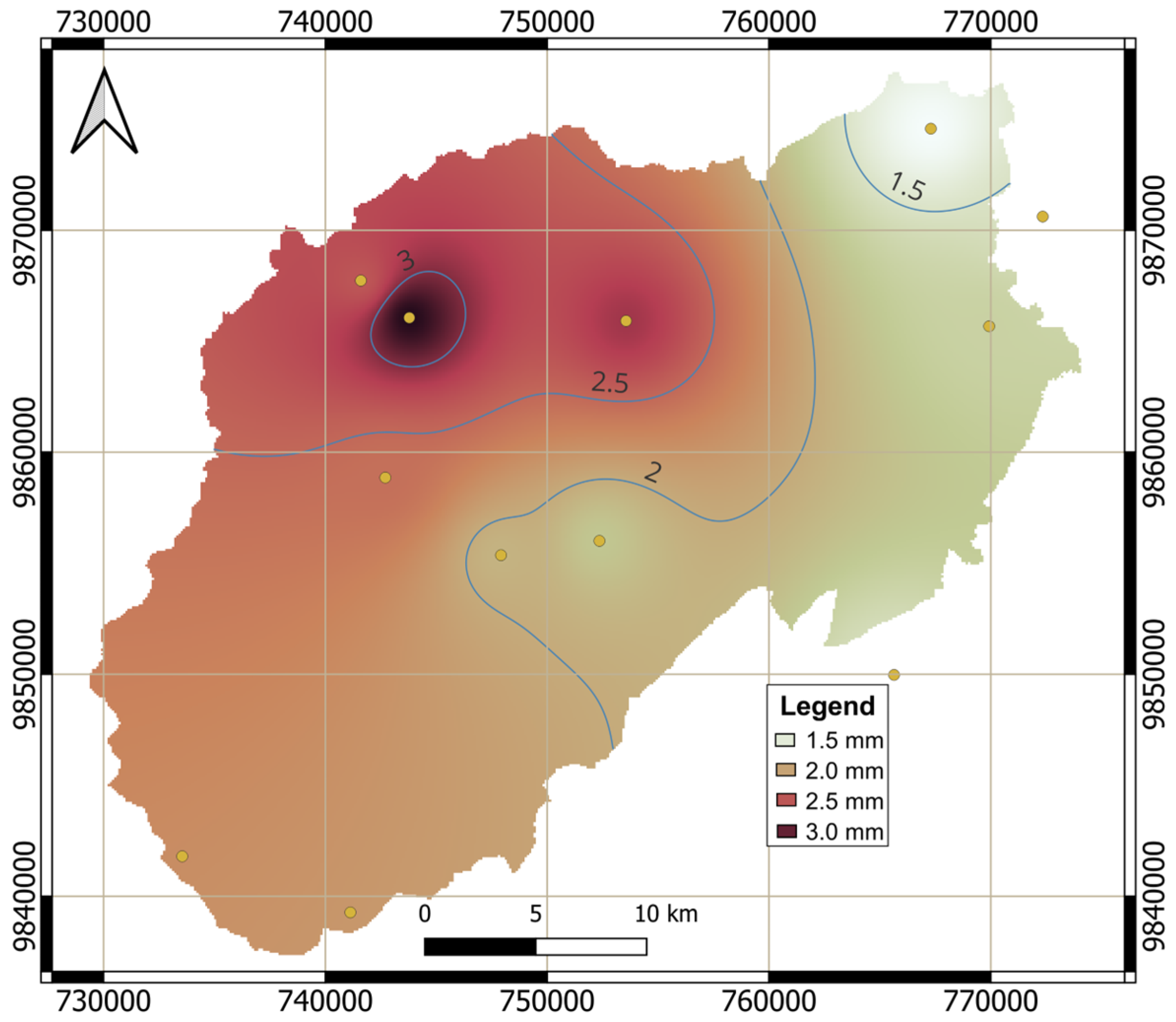
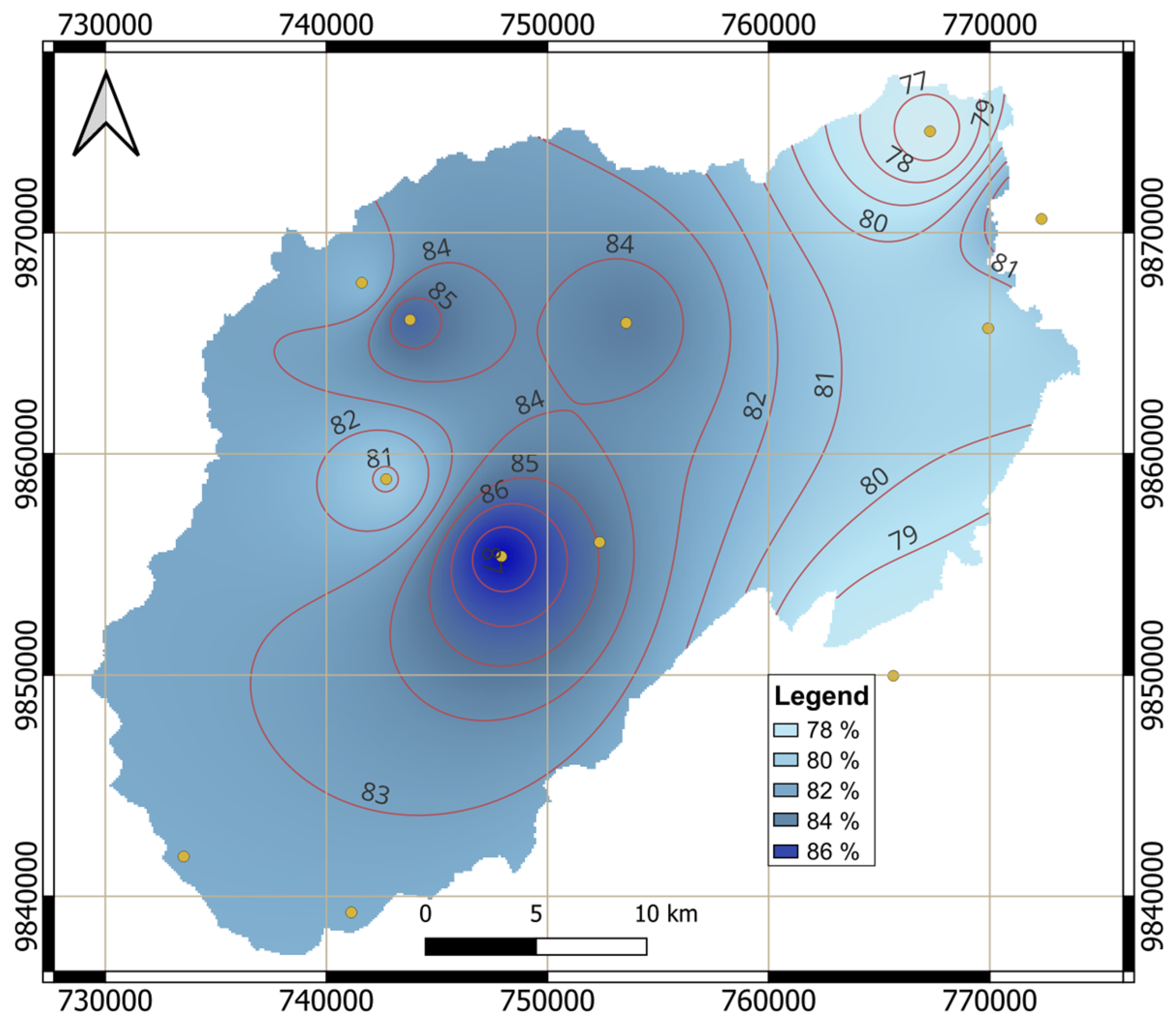
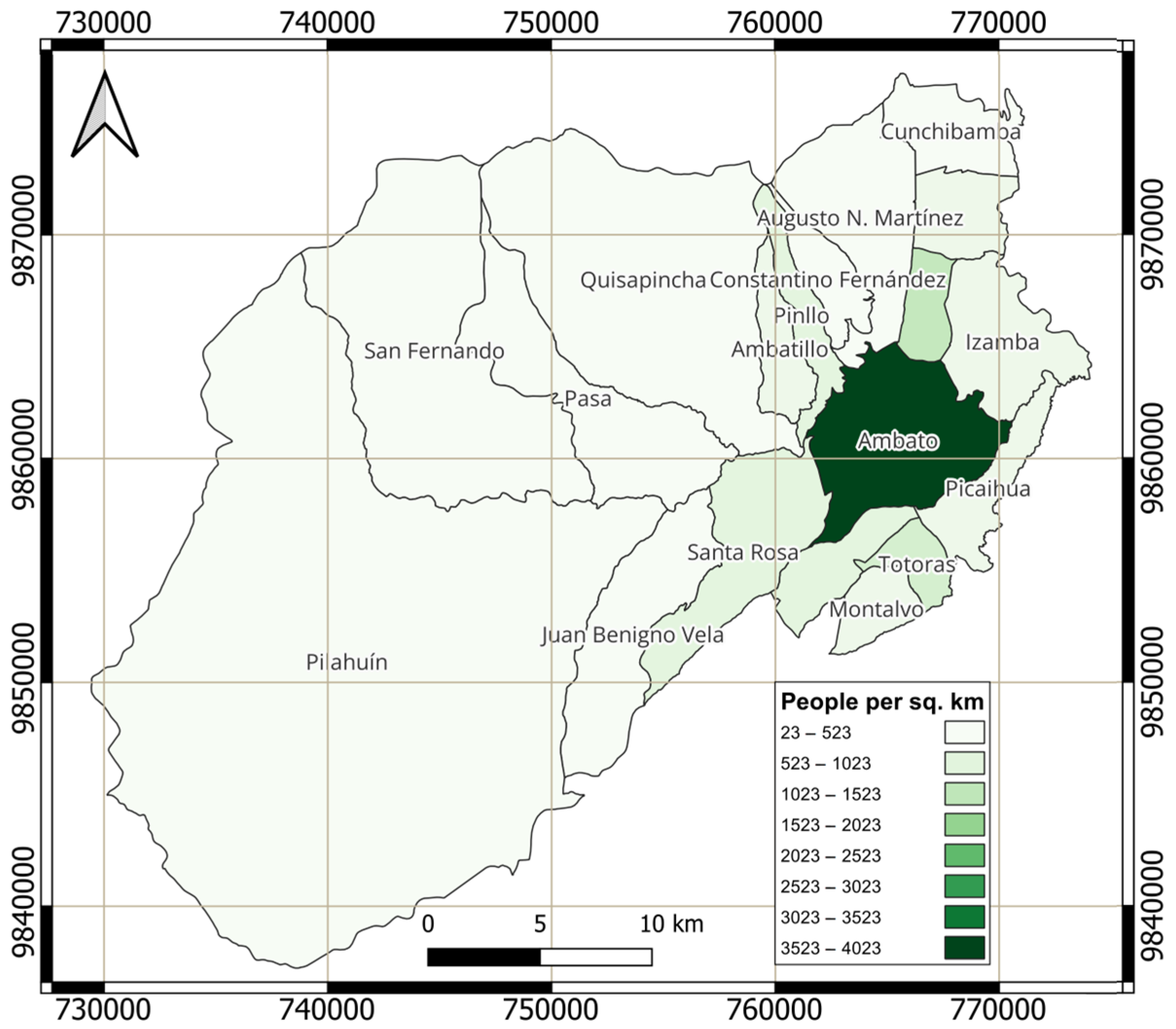
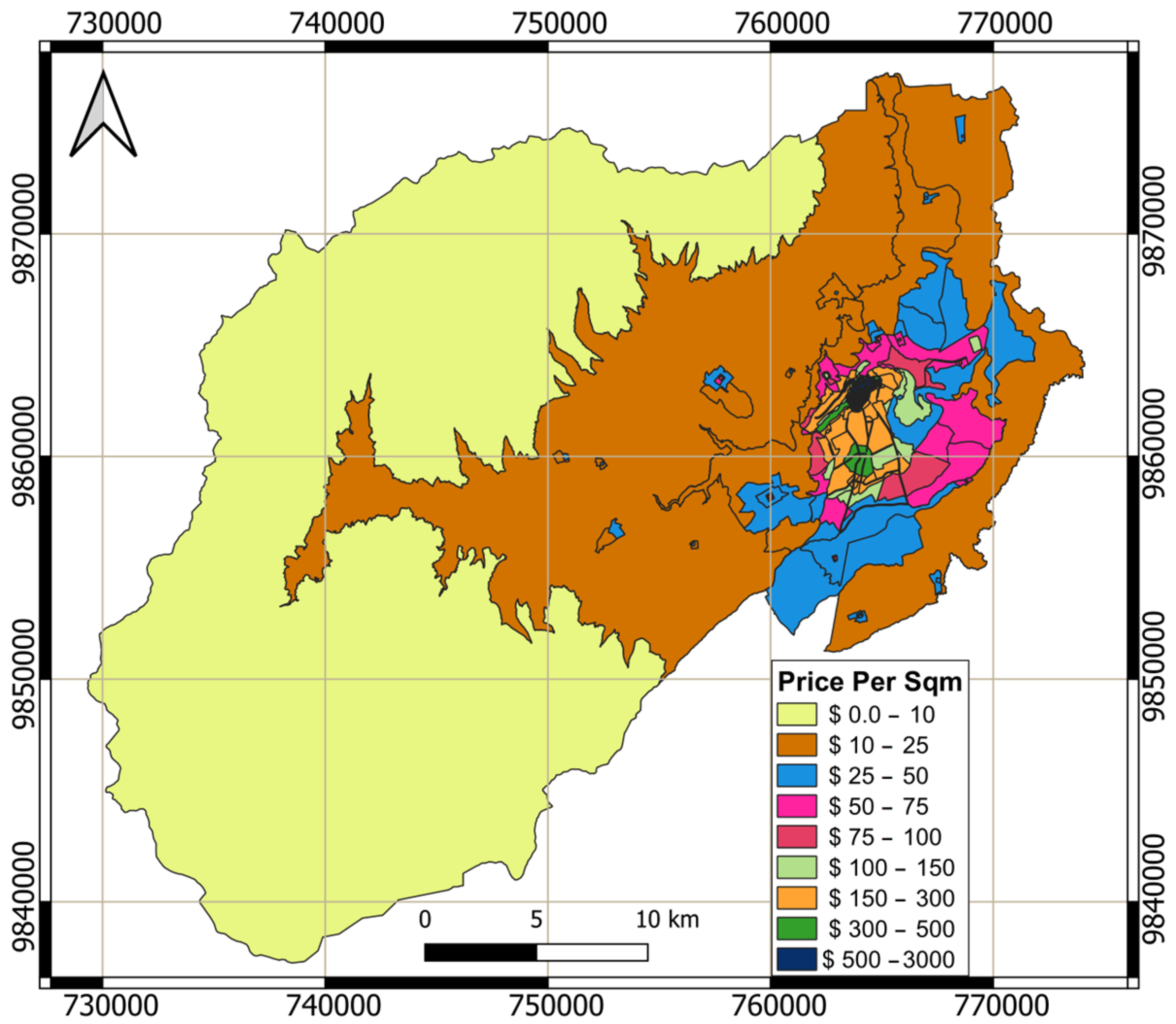
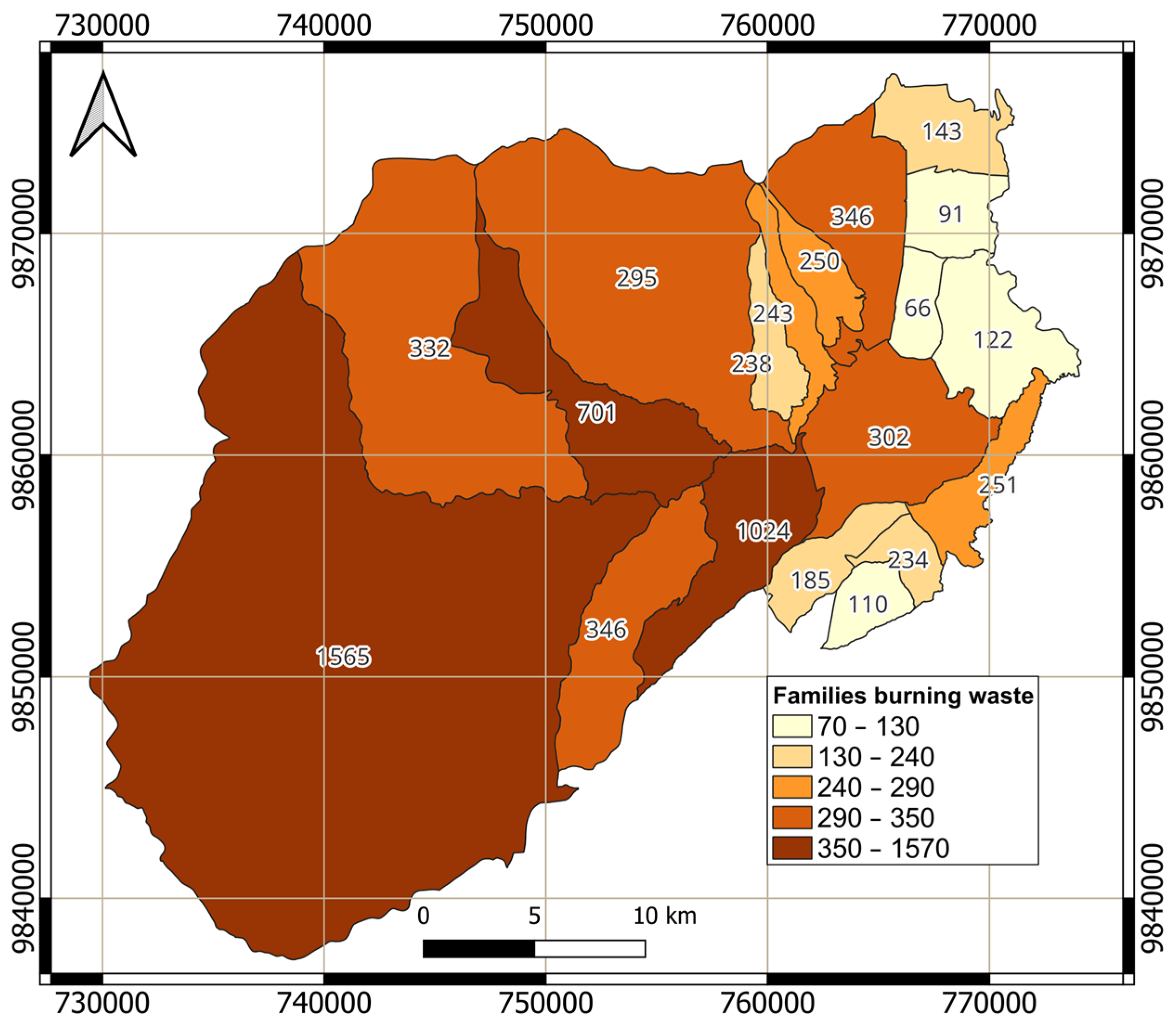



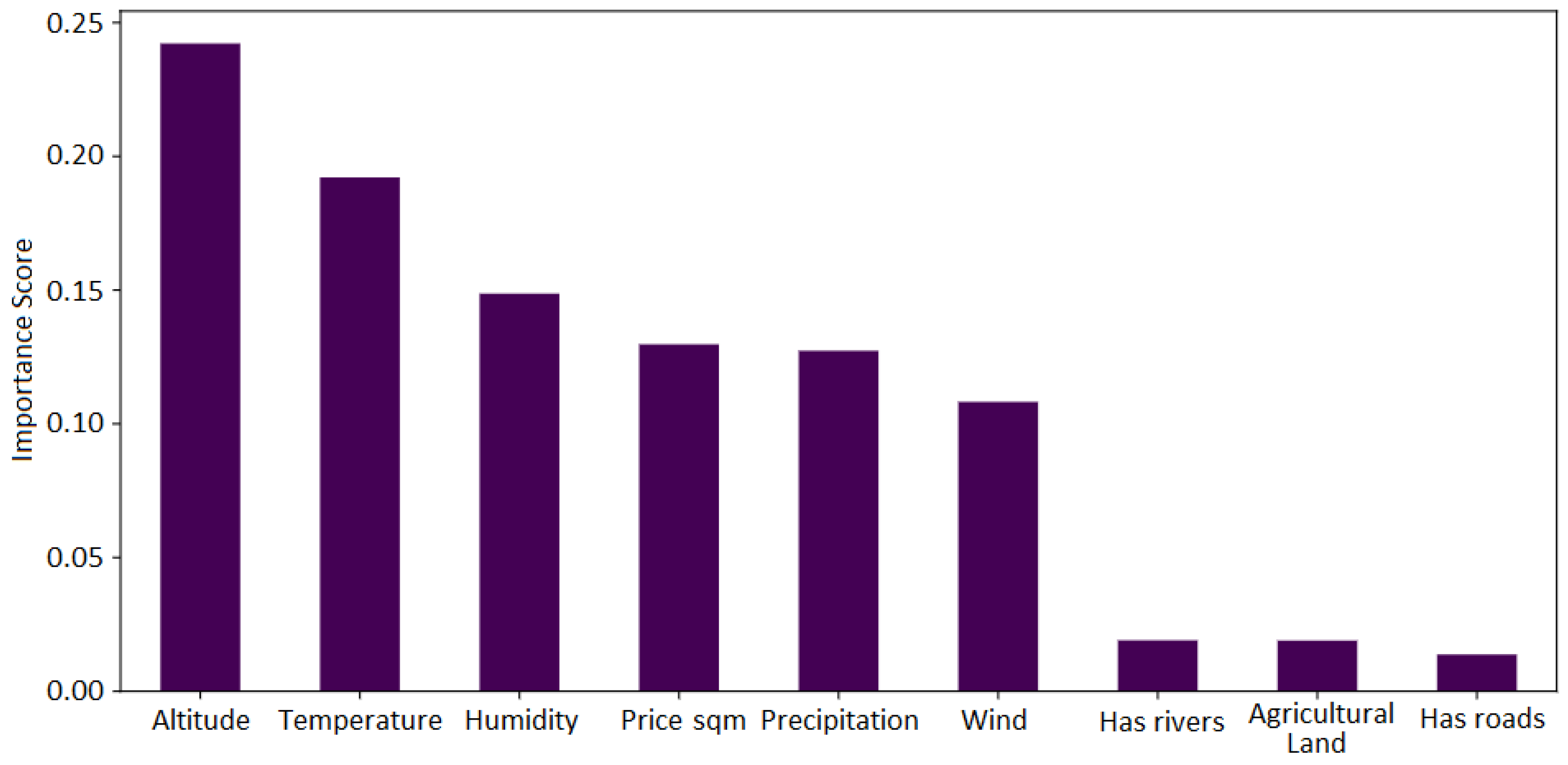
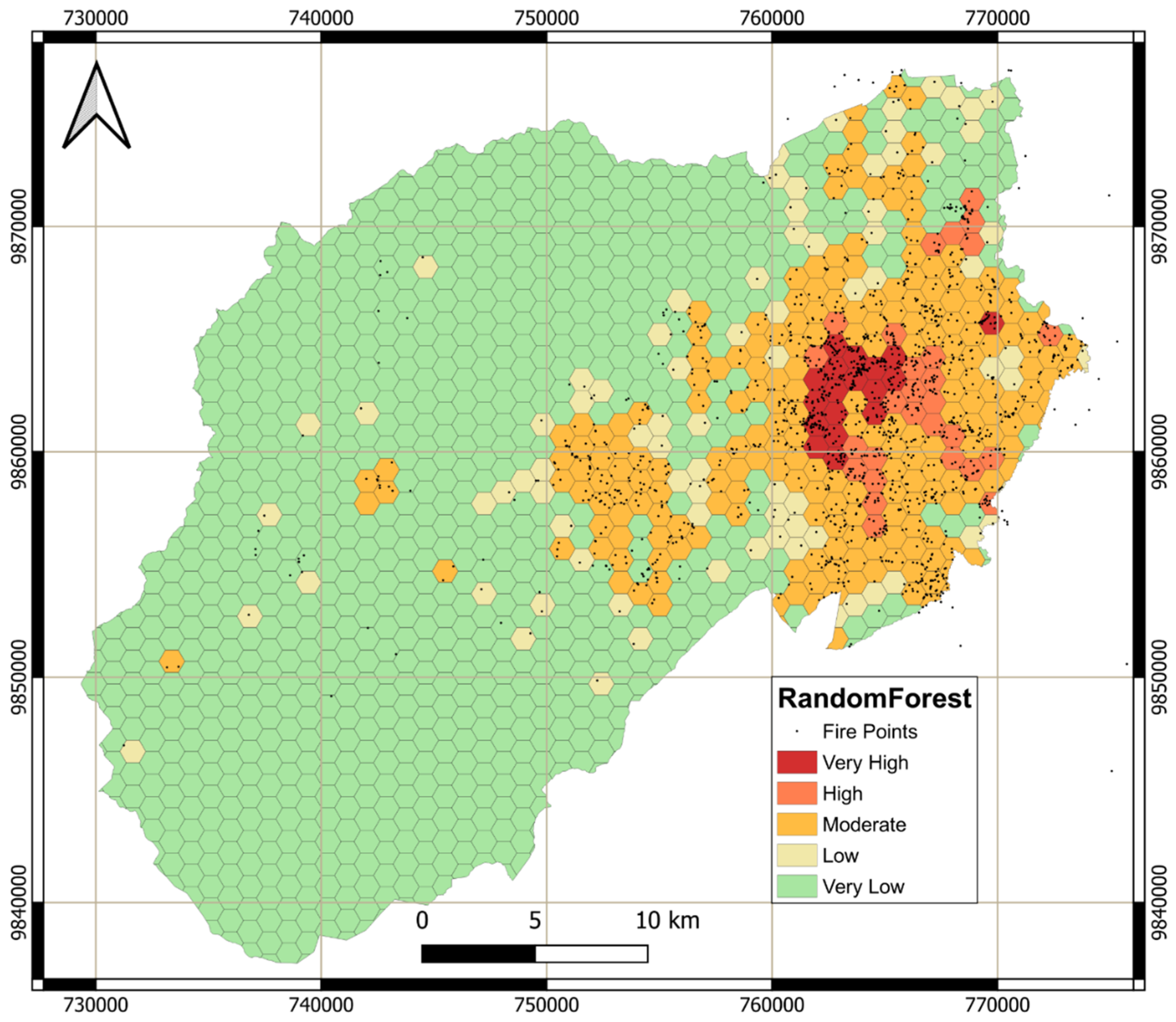
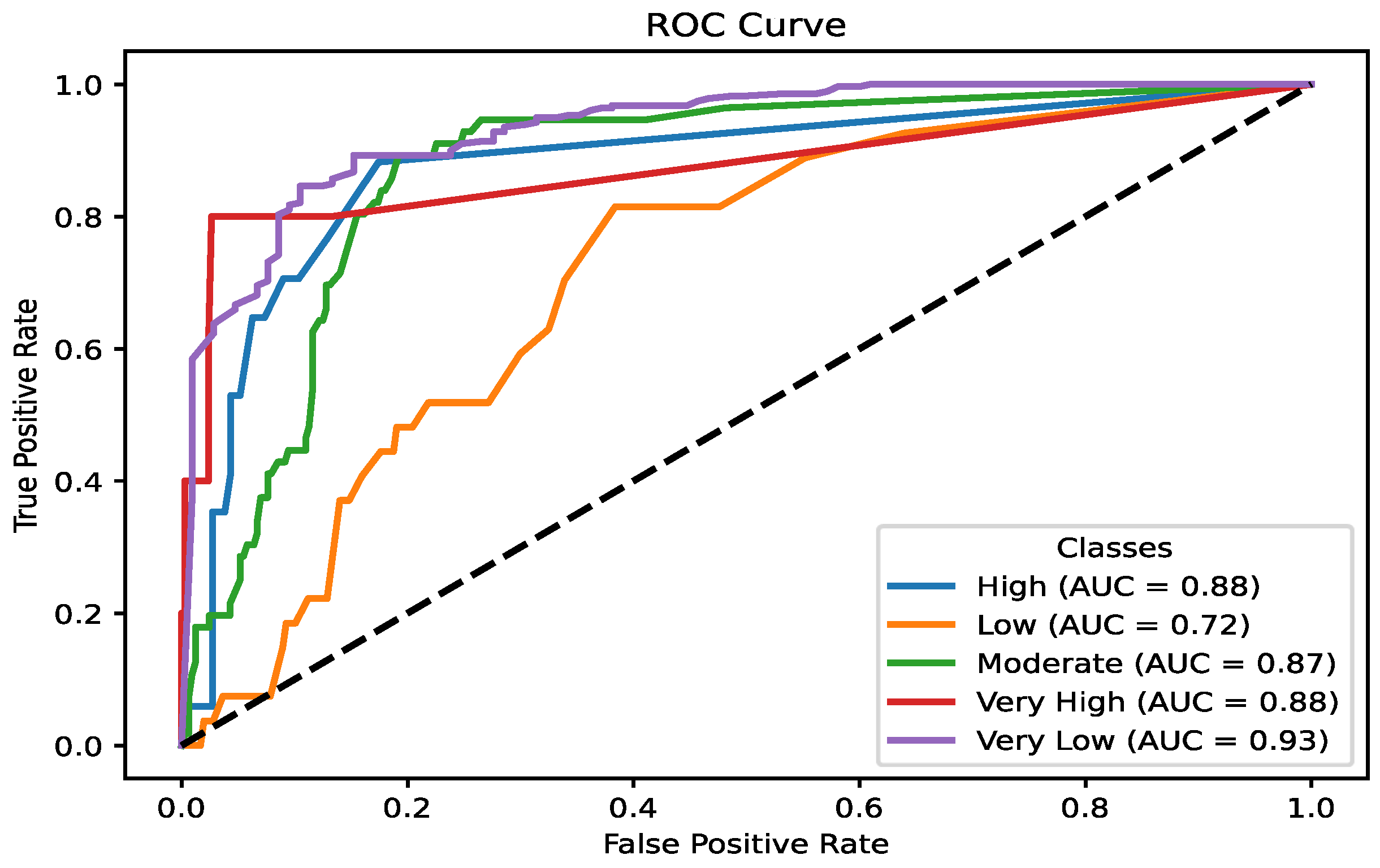

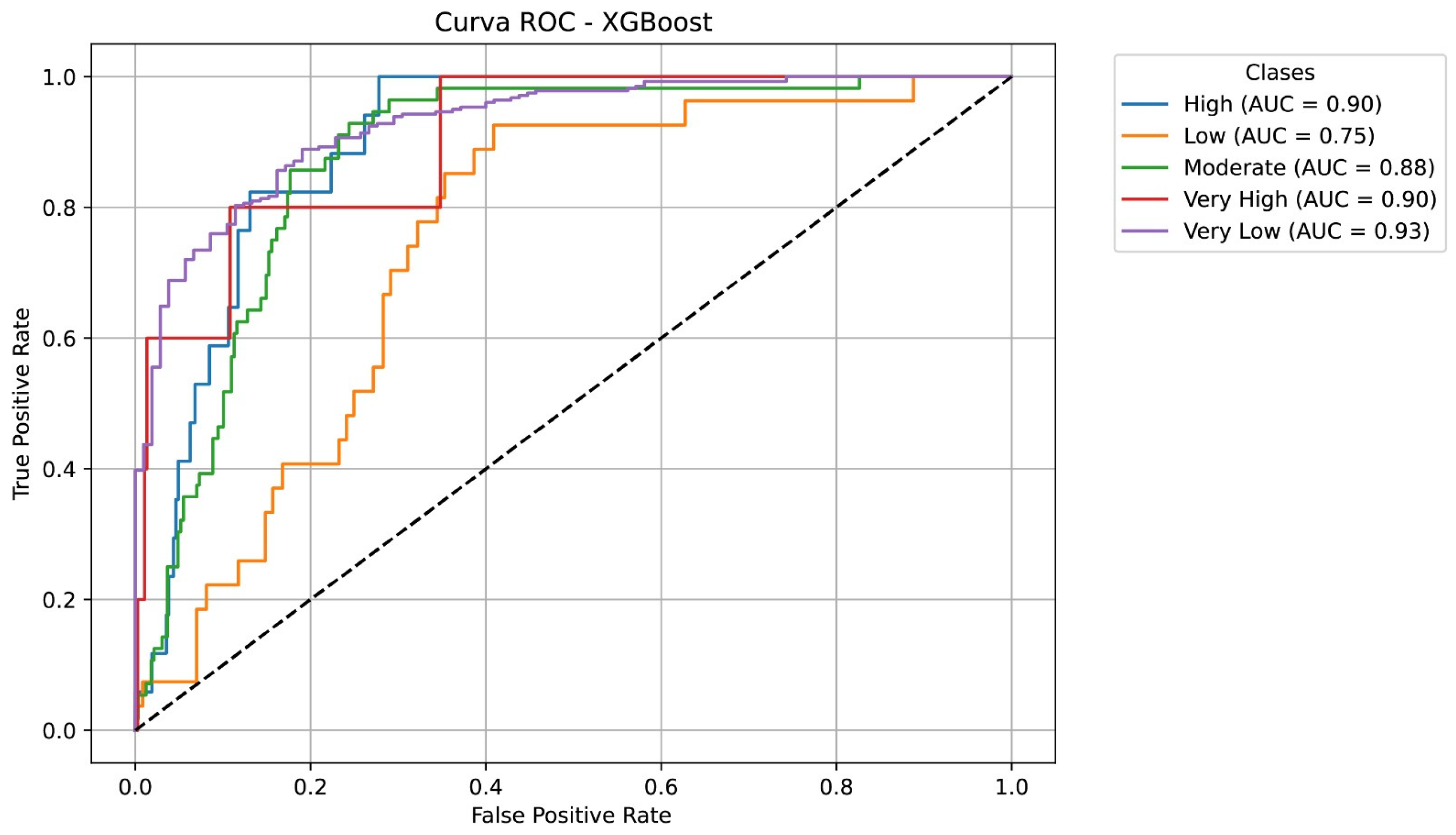
| Station | X (UTM) | Y (UTM) | Parish | Relative Humidity (%) | Daily Precipitation (mm) | Wind Speed (m/s) | Temperature (°C) |
|---|---|---|---|---|---|---|---|
| Aeropuerto | 769929 | 9865679 | Izamba | 80.1 | 1.7 | 2.0 | 13.9 |
| Calamaca | 742705 | 9858860 | San Fernando | 80.9 | 2.4 | 2.6 | 8.4 |
| Chiquihurcu | 743787 | 9866064 | San Fernando | 85.6 | 3.3 | 2.6 | 6.6 |
| Quisapincha | 753559 | 9865921 | Quisapincha | 84.6 | 2.9 | 2.0 | 7.1 |
| Mula Corral | 741602 | 9867738 | San Fernando | 82.0 | 2.6 | 2.1 | 6.2 |
| Tamboloma | 747919 | 9855365 | Pilahuin | 87.6 | 1.9 | N/D * | 7.3 |
| Pilahuin | 752358 | 9856011 | Pilahuin | N/D | 1.8 | N/D | N/D |
| Hacienda Cunchibamba | 767300 | 9874583 | Cunchibamba | 76.4 | 1.2 | 2.6 | 13.1 |
| Hacienda Guadalupe | 778853 | 9849321 | Patate | 69.1 | 1.8 | 2.3 | 16.4 |
| Unidad Educativa Cevallos | 765641 | 9849972 | Cevallos | 77.9 | 1.5 | 1.7 | 12.7 |
| Unidad Educativa Jorge Alvarez | 772342 | 9870622 | Pillaro | 84.2 | 1.5 | 2.0 | 12.0 |
| Parish | 2017 | 2018 | 2019 | 2020 | 2021 | 2022 | 2023 | Total (ha) | Households Involved in Open Waste Burning |
|---|---|---|---|---|---|---|---|---|---|
| Ambatillo | 0.2 | 22.8 | 0.1 | 3.2 | 2.1 | 27.9 | 3.8 | 60 | 238 |
| Ambato | 2.3 | 7.5 | 17 | 8.5 | 10.7 | 4.8 | 39.8 | 90.6 | 302 |
| Atahualpa | 0.4 | 1 | 8.6 | 0.8 | 0 | 0.3 | 1.1 | 12.3 | 66 |
| Augusto N. Martínez | 0.1 | 15.6 | 1.6 | 5.3 | 0 | 30.4 | 15.3 | 68.2 | 346 |
| Constantino Fernández | 53 | 0.6 | 3.3 | 6 | 0 | 10.4 | 18.4 | 91.7 | 250 |
| Cunchibamba | 0 | 2.5 | 7 | 3 | 0 | 0.1 | 2.3 | 15 | 143 |
| Huachi Grande | 0.4 | 0.6 | 0.1 | 0.8 | 0 | 1.5 | 1 | 4.5 | 185 |
| Izamba | 1.4 | 22.7 | 10.6 | 609 | 0.1 | 28.2 | 212.9 | 884.9 | 122 |
| Juan Benigno Vela | 10.1 | 9.3 | 1.1 | 17.8 | 0 | 5.5 | 44.3 | 88.2 | 346 |
| Montalvo | 0.1 | 0.1 | 1.2 | 0.3 | 0.1 | 0 | 2.1 | 3.9 | 110 |
| Pasa | 22.1 | 93.1 | 6.1 | 26.7 | 0.6 | 31.8 | 156.5 | 337 | 701 |
| Picaihua | 1.3 | 5.2 | 1.5 | 6.5 | 0 | 3.2 | 10.3 | 27.9 | 251 |
| Pilahuín | 1.2 | 50 | 15 | 15.8 | 0 | 40.9 | 94.7 | 217.6 | 1565 |
| Quisapincha | 8 | 93.9 | 8.4 | 23.2 | 10 | 41.9 | 10.1 | 195.4 | 295 |
| San Bartolomé de Pinllo | 151.6 | 1.9 | 3.3 | 1.7 | 1.1 | 5.8 | 50.6 | 216 | 243 |
| San Fernando | 0.1 | 18.1 | 3 | 150.8 | 0 | 58.1 | 31.1 | 261.2 | 332 |
| Santa rosa | 0.2 | 3.4 | 2.1 | 13 | 13.3 | 0.2 | 4.8 | 37 | 1024 |
| Totoras | 0.9 | 0.9 | 0.5 | 0.5 | 0.2 | 4.2 | 1.4 | 8.5 | 234 |
| Unamuncho | 1.3 | 2.4 | 0.7 | 8.4 | 0 | 0.5 | 5.6 | 18.9 | 91 |
| Outside the city | 10.1 | 320.5 | 116.6 | 598.8 | 0 | 10 | 85.4 | 1141.3 | N/D * |
| Total | 264.7 | 672.1 | 207.7 | 1500.1 | 38.2 | 305.7 | 791.4 | 3780 | 6844 |
| Public Policy | Objective | Specific Actions | Intended Outcome |
|---|---|---|---|
| Enhance wildfire monitoring systems | Strengthen early detection and response capacity. |
| Enhance wildfire monitoring systems |
| Regulate solid waste management | Reduce fuel accumulation in forested areas. |
| Regulate solid waste management |
| Control invasive species | Prevent rapid fire spread. |
| Control invasive species |
| Promote environmental education | Encourage responsible practices to prevent wildfires. |
| Promote environmental education |
| Regulate land use in the wildland–urban interface | Minimize risks in areas near residential zones. |
| Reduced property losses in wildfires near urban communities. |
| Foster interinstitutional cooperation | Coordinate efforts among key stakeholders. |
| Foster interinstitutional cooperation |
Disclaimer/Publisher’s Note: The statements, opinions and data contained in all publications are solely those of the individual author(s) and contributor(s) and not of MDPI and/or the editor(s). MDPI and/or the editor(s) disclaim responsibility for any injury to people or property resulting from any ideas, methods, instructions or products referred to in the content. |
© 2025 by the authors. Licensee MDPI, Basel, Switzerland. This article is an open access article distributed under the terms and conditions of the Creative Commons Attribution (CC BY) license (https://creativecommons.org/licenses/by/4.0/).
Share and Cite
Hidalgo, A.; Contreras-Vásquez, L.; Nuñez, V.; Paredes-Beltran, B. Wildfire Risk Assessment in Ambato, Ecuador: Drought Impacts, Fuel Dynamics, and Wildland–Urban Interface Vulnerability. Fire 2025, 8, 130. https://doi.org/10.3390/fire8040130
Hidalgo A, Contreras-Vásquez L, Nuñez V, Paredes-Beltran B. Wildfire Risk Assessment in Ambato, Ecuador: Drought Impacts, Fuel Dynamics, and Wildland–Urban Interface Vulnerability. Fire. 2025; 8(4):130. https://doi.org/10.3390/fire8040130
Chicago/Turabian StyleHidalgo, Andrés, Luis Contreras-Vásquez, Verónica Nuñez, and Bolivar Paredes-Beltran. 2025. "Wildfire Risk Assessment in Ambato, Ecuador: Drought Impacts, Fuel Dynamics, and Wildland–Urban Interface Vulnerability" Fire 8, no. 4: 130. https://doi.org/10.3390/fire8040130
APA StyleHidalgo, A., Contreras-Vásquez, L., Nuñez, V., & Paredes-Beltran, B. (2025). Wildfire Risk Assessment in Ambato, Ecuador: Drought Impacts, Fuel Dynamics, and Wildland–Urban Interface Vulnerability. Fire, 8(4), 130. https://doi.org/10.3390/fire8040130








